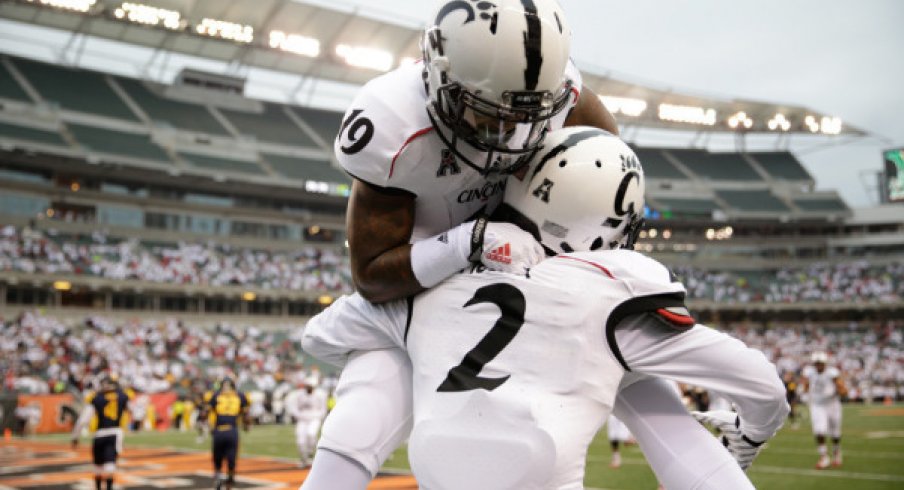So far, the Cincinnati offense has been dominant in 2014.
Led by the aptly named Gunner Kiel, the Bearcats have put up staggering numbers in the passing game, averaging 353 passing yards-per-game. Kiel and his talented cast of receivers have simply overwhelmed their opponents, breaking a number of big plays on their way to two wins over in-state opponents Toledo and Miami University.
While still trying to break in a new pass defense under coordinator Chris Ash, the Ohio State Buckeyes certainly have their work cut out for them in this weekend's matchup in Ohio Stadium. But Saturday night will be a big test for both sides, as U.C. heads to Columbus to take on a much more talented defense than either they've seen thus far.
The Bearcats run an uptempo, no-huddle offense that functions almost exclusively from the shotgun with four receivers split out wide. With a deep and versatile receiving corps, they're able to execute a wide-ranging game-plan without substituting to keep defenses on their heels.
Though the Bearcats are quite diverse in scheme, they manage to do so while usually running four main base formations:
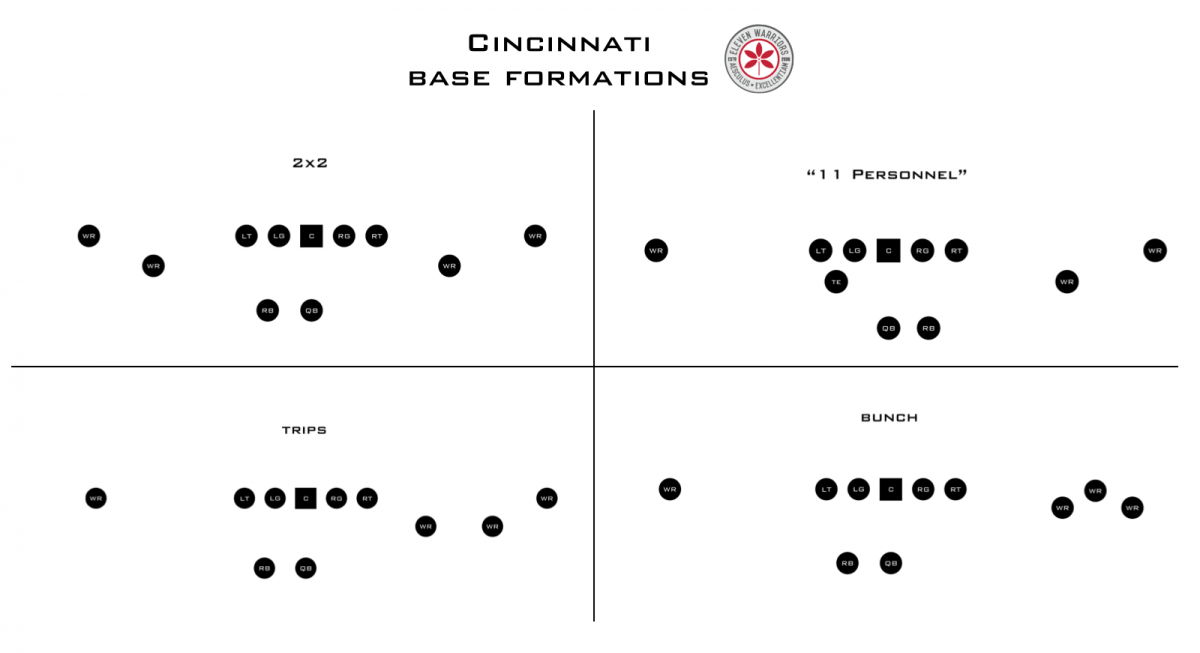
As seen in the diagram above, only one of their base formations involves a tight end, with the remaining alignments all calling for "10" personnel (1 running back, 0 tight ends). When tight end DJ Dowdy (#81) is in the game, they like to run the ball behind him with inside zone, then immediately follow up on the next play with something that initially looks the same, like a counter-trey or play-action pass.
Dowdy doesn't need to be in the game for the Bearcats to run the ball, as they're more than happy to spread out a defense and run inside against a 6-man box. The UC offensive line is massive, experienced, and known for keeping their QB clean, finishing in the top 20 in sacks allowed last year.
Running backs Hosey Williams (#23) and Tion Green (#7) are both well-rounded backs, able to catch and block out of the backfield. Although Williams is the starter, the two split carries fairly evenly and have averaged just over 100 yards per game combined, with a yards-per-carry average of just over five. Both benefit greatly from defenses looking to stop the pass first though, but have proven very effective near the goal line, with five rushing touchdowns between them already.
In addition to the Inside Zone and counters, the Bearcats love to run draws and throw screens to the running backs. By presenting such a threat to throw downfield, defensive lines are often on a straight line to the QB, and leave running lanes wide open for these delayed handoffs and short throws.
Kiel will also take part in the running game, regularly keeping the ball off an inside zone-read option and allowing the 5-man offensive line to account for all the defenders near the line by optioning an end. But the quarterback is not a spectacular athlete, and though he has decent size, running in the open field against Ohio State is different than doing so against Miami or Toledo. These options may be called far less on Saturday, as coach Tommy Tuberville will need Kiel's arm far more than his legs, and there's no reason to put him at such risk.
Occasionally the Bearcats will get into a 5-wide formation, but thus far it has always involved one of their quicker receivers like Ralph David Abernathy(#1) or Johnny Holton (#3) coming in motion to the backfield, sometimes for a handoff on a jet sweep or to catch a swing pass. This set allows the Bearcats to stretch a defense across the field and then quickly get the ball to some of their most dangerous athletes in space quickly.
But the one receiver the Buckeyes absolutely must make sure doesn't get loose in space is Shaq Washington (#19). The junior from Maple Heights led the Bearcats in receptions last year, and has already caught 11 balls this season.
Washington mostly gets involved in the screen game, however. Very few of his catches come down the field, and the UC coaches do a very good job getting creative with the way they get him the ball. Nearly every kind of wide receiver screen out there is in the Bearcat playbook, with bubble, smoke, and tunnel screens getting called the most.

Unlike the bubble or smoke screens, which only call on the other receivers nearby to block, the tunnel screen gets Washington the ball with his offensive line as the lead blockers. Although it takes more time to develop than those two, the potential for a big play is huge.
The Buckeye linebackers must read the pulling offensive linemen quickly and beat them to their marker, ending the play before the blocking can get set up. Getting caught in traffic or making a false read before recognizing the play could be the difference between a 2 yard gain and a trip to the end zone when a player like Washington has the ball.
There's no question that the trademark of Bearcat offense is their ability to throw downfield. While "Air-Raid" teams like Washington State Texas A&M might throw the ball more often, those offenses are built around short, horizontal routes that are meant to get the ball out quickly.
But the Cincinnati offense has no problem looking to beat you downfield, as they have the physical weapons to do so.
Thanks to Kiel's strong arm, the Cincinnati attack is able to stretch defenses vertically in ways not often seen at the college level. In many ways, their scheme most resembles a no-huddle version of the Florida Gators "Fun-n-Gun" offense under Steve Spurrier in the mid 90's.
Although Washington isn't a huge factor downfield, his fellow junior wide-outs Mekale McKay (#2) and Max Morrison (#82) are good route runners that have proved very difficult to defend, no matter the coverage.
Morrison has the best hands in the group, as well as a knack for recognizing zone coverages and finding the soft spots. Usually operating out of the slot, the UC coaching staff gives him the freedom to adjust his routes on the fly, proving to be a serious threat on third downs.
The Bearcats love to run a bunch formation with Washington, Morrison, and the fourth starting receiver, Chris Moore (#15), that splits the three out very wide. By stacking all three next to each other that far from the ball, defenses are forced to move their own players away, not only leaving room to run the ball, but also leaving McKay in one-on-one coverage on the opposite side.
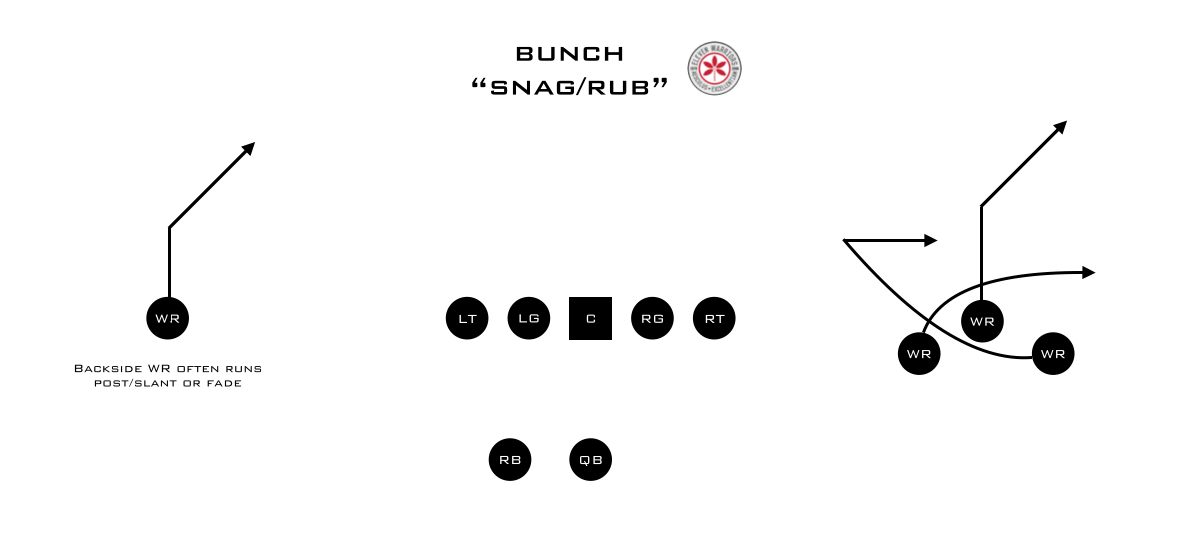
There is no one proven way to defend bunch formations like this, but one can surmise that the Buckeyes will walk out SAM linebacker Darron Lee to that side along with the cornerback and a safety on top. But the UC coaches love to run routes like the Snag concept above which see the receivers criss-crossing and creating natural "picks" for defenders in man coverage.
Knowing teams are more comfortable defending these concepts with a zone is a big reason they like to run this in the red zone. Defenses will be punished for sitting back and waiting for the UC receivers to declare their routes, as that's enough time for Kiel to fire the ball into an open window.
If defenses overplay the bunch, then the inside run is usually opened up, allowing Williams and Green to get some fairly easy scores. But the biggest stretch the bunch puts on defenses is the threat of the backside receiver, McKay.
After hauling in seven touchdown catches in 2013 (on only 16 receptions), McKay has carried that momentum into 2014 on his way to leading the team in catches, yards, and touchdowns. Not only has he quickly become Kiel's favorite target, he's doing so down the field, averaging 18 yards-per-catch.
Though he's not a burner, McKay's 6'6" frame creates a big target for Kiel. While he has dropped a couple easy catches, he shouldn't be mistaken for a young athlete that doesn't know how to play the position. Instead, he is a good route runner for someone his size, and knows how to use it to his advantage, often shielding his defender from making a play on the ball.
When paired on the outside with inside receivers like Morrison or Washington, the Bearcats know that defenses can't overplay either receiver to that side, often leading to single coverage.
Since most defenses at this FBS level now operate out of the same Cover 4 scheme the Buckeyes run, Cincinnati knows that by releasing their receivers vertically, they'll effectively be in single, man coverage from one of the four defensive backs.
While this provides the defense with a solution to stop the four receivers when they run "4 verticals" it leaves them exposed to any deviations in their pattern, such as a post or dig route. As such, the Bearcats regularly pull out two staples from the Fun-and-Gun playbook, the "Mills" and "Fade" concepts.
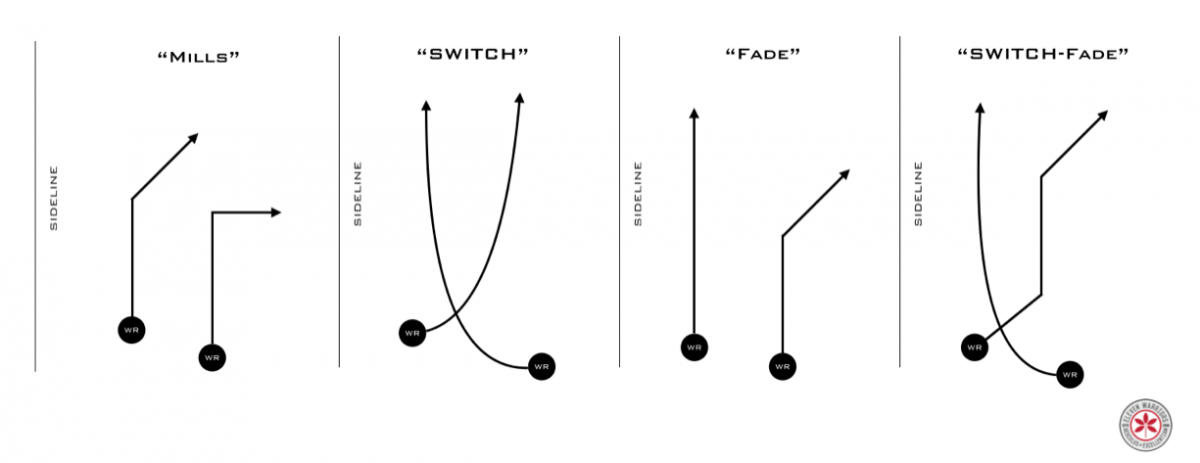
Even when teams play press coverage on the outside, the Bearcats are able to respond by calling "switch" and forcing the defenders to immediately trade responsibilities, negating any of the benefits of pressing.
The Bearcats will call for these concepts in any situation, as they proved on their first play from scrimmage against Toledo, calling Mills and connecting for a big gain.
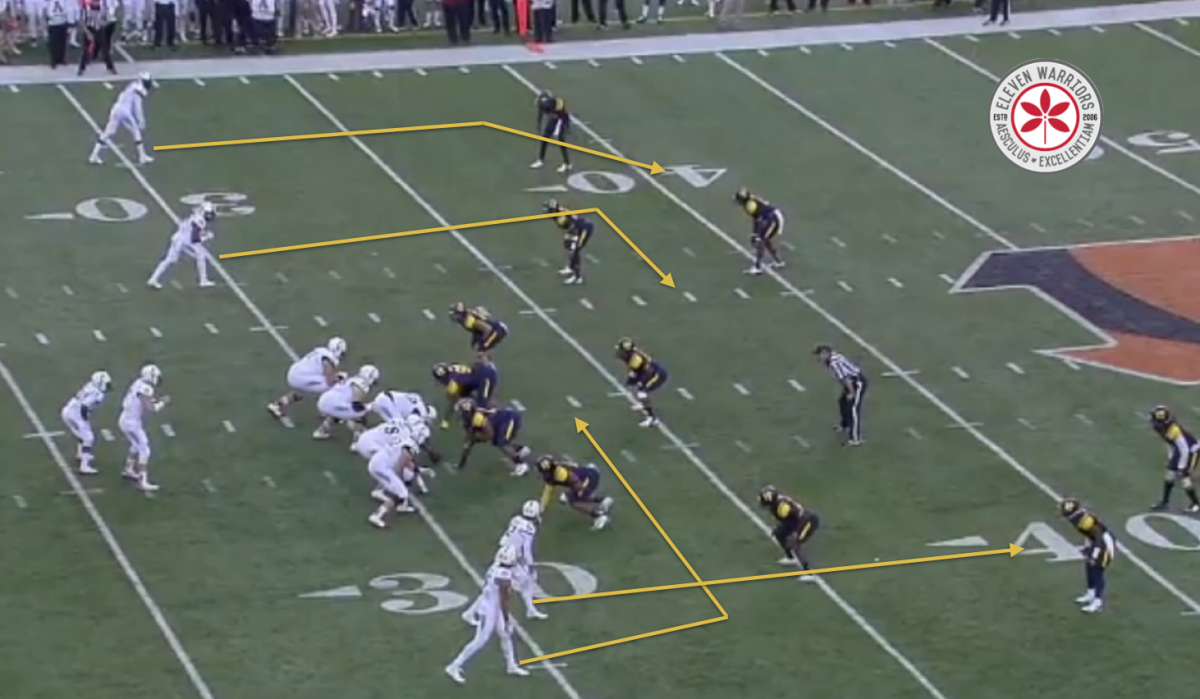
By running the inside cross just past the linebackers, the safety is forced to come up and take on that route, leaving the corner completely exposed. As an insurance policy, the Bearcats bring Moore across the middle on a short crossing route, ensuring the linebackers will be up far enough, creating a vertical stretch on the defense.
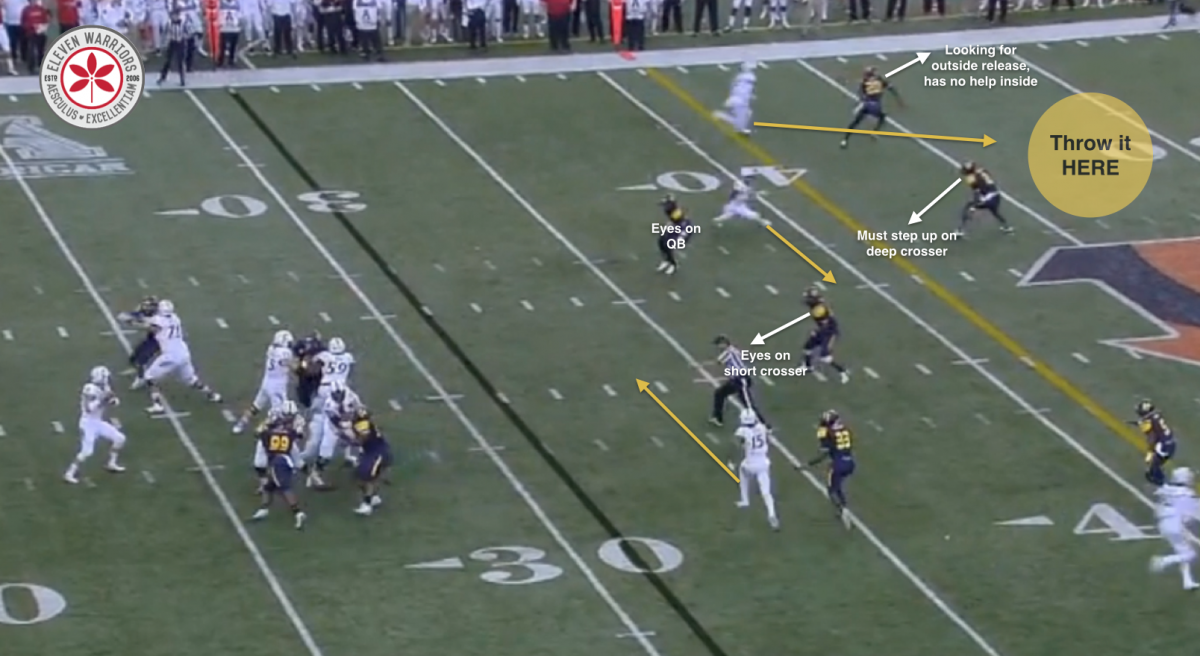
The cornerback covering McKay on the outside is so scared of getting beat deep, he turns his hips too quickly, and leaves himself exposed to the inside where there is now no safety to help. Kiel and McKay have an easy throw and catch that results in a 52-yard gain, and setting the tone right away.
Though the Buckeyes will certainly have their hands full, the Bearcats aren't perfect.
Kiel is confident in both his abilities, as well as those of his receivers, and isn't afraid to try to fit the ball in to tight spots that aren't really open. Additionally, he is only making his third start ever on Saturday, and as a young QB, he has tendency to lock on to his intended receivers.
Both traits led to interceptions against Miami, and the Redhawks could have had more if they had been able to hold on to the ball. The Buckeyes have better athletes in the secondary than both Toledo or Miami, and giving them the chance to break on the ball will come back to haunt Kiel if he does so.
The Cincinnati receivers can also be fairly predictable. If Washington releases downfield, he's generally only running a straight, vertical route. McKay lines up almost exclusively outside, and rarely runs any kind of crossing route. Morrison is the most versatile in his route-running, but the least explosive.
Though they'll probably complete a high number of passes early on in the game, the UC coaches will have to be more diverse in how they take advantage of each receiver's strengths. The strength of the Ohio State's Cover 4 is the ability to make small changes on the fly to adapt to what the offense likes to do, without having to change much in alignment or overall scheme. Eventually the Buckeyes will see enough of each trick to slow them down, as was the case against Virginia Tech, the only team to stress the Buckeye secondary this season.
Finally, though the Bearcats have been excellent for the past two years at keeping their quarterbacks upright, they're in for a long night against the Buckeyes defensive line. The best UC lineman, left tackle Eric Lefeld, is often left one-on-one against the best opposing pass rusher, and has already been beaten once by a simple speed rush move.
Though Lefeld has a chance to play on Sundays, he'll likely move inside, as he lacks the natural athleticism needed to stop pass rushers like Joey Bosa. Their matchup will be one to watch on Saturday, as the Buckeyes have a talent advantage at virtually every spot along the line and Lefeld will have to fend for his own without any help.
If the Buckeyes are able to get consistent pressure on Kiel, the entire UC offensive machine could have a lot of trouble getting started. The entire game plan of the Bearcats is predicated on seeing defenses playing back, afraid of getting by the talented group of receivers. But those deep, vertical routes take time to develop, and the Buckeyes can shut them down by forcing Kiel to get rid of the ball too quickly and making him uncomfortable in the pocket.
The Buckeyes have all the tools you'd want to shut down this Cincinnati attack. But the onus falls on players like Doran Grant to show that they're capable of executing. If Grant can neutralize McKay on the outside, staying true to his responsibilities and not gambling or guessing, the Buckeyes can slowly dismantle the UC attack, piece by piece.
In all, this Saturday offers the Buckeye pass defense a chance to make a statement. This will be the best passing attack they'll see all year, so if the OSU secondary wants to put last year's demons to rest, this is the week to do it. Let's see if they're up to the task.
